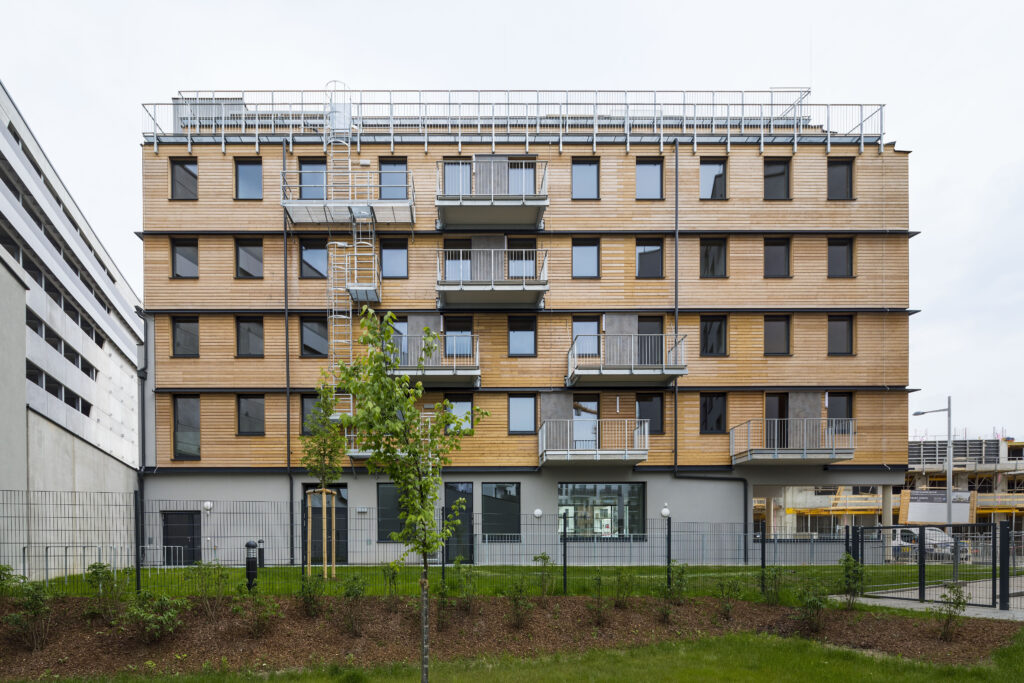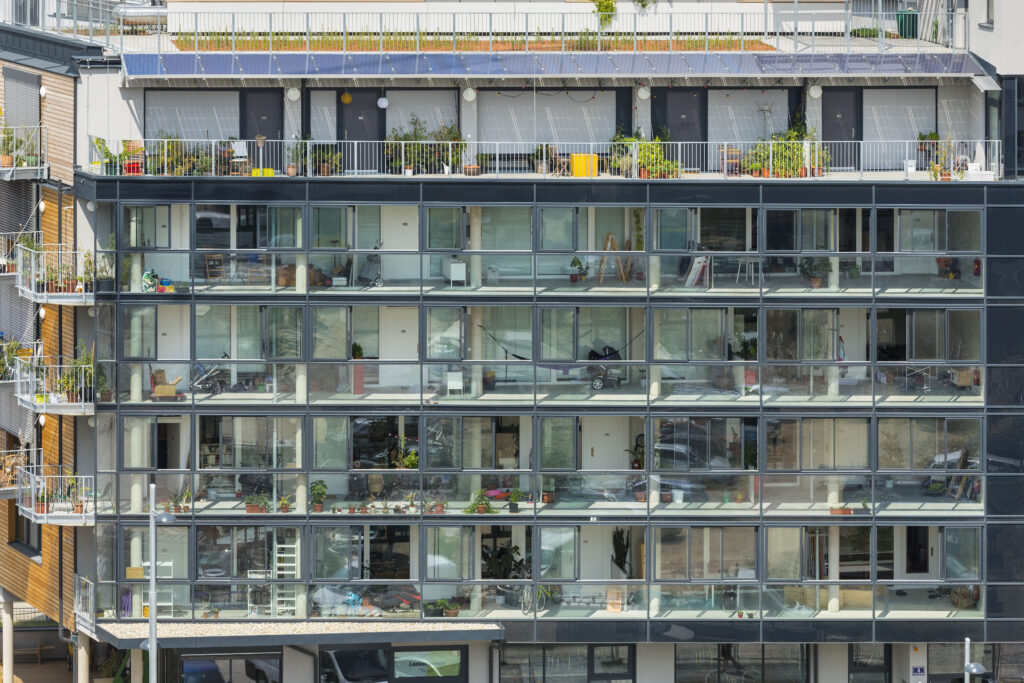044 Bikes and Rails
Location: Emilie-Flöge-Weg 4, Vienna, Austria
Owner/investor: Bikes and Rails
Architects: Architekturbüro Reinberg ZTGmbH
Project type: Co-house

Introduction: This cohousing project was planned by the residents together with the architect and a property developer. It was built within the framework of social housing. It is located within an innovative new district built on an inner-city former railway site.
Comfort:
The residential part of this project is built entirely of wood (5 floors, wooden stud walls and visible cross laminated timber ceilings). This residential part is placed on a concrete ground floor (with a common room and bicycle cafe) and attached to the concrete construction of the wintergarden.Vertical access to the apartments is via a spacious,daylight-lit staircase. A south-facing, multi-storeyconservatory, which is also used for access to theunits and is completely glazed, contributes to theenrichment of the district additonally bycommunicating through the glas. Thisconservatory offers the maximum possibleexposure even on cloudy winter days. Theresidents use the conservatory not only forhorizontal access to the apartments, but also as acommon area (cluster). Each apartment has a”semi-private” loggia within this winter garden.There is a fully glazed wall between theconservatory and the individual living areas, sothat there is also plenty of daylight in theapartments. In addition, the apartments are also litvia the north facade. On the ground floor, thebicycle café, the common room and the bicycleworkshop can be flexibly combined and used. Theroof terrace and the small green area on theground floor are designed and used jointly. Theproperty management is organized jointly by theinhabitants.
The thermal comfort is guaranteed by thebioclimatic construction material (exposedwooden ceilings, wooden floors, wooden windowsand doors etc.) and by the high thermal insulation.
Ventilation is automatically controlled accordingto actual needs and the apartments can also becross-ventilated.
Adequate daylighting was verified mathematically.the calculations were carried out with the lightsimulation program RELUXpro.

Thanks to the high thermal insulation and theventilation system, the compact structurecorresponds to the passive house standard. Theventilation takes place via a ventilation systemwith heat recovery, the air distribution via twovertical shafts. The conservatory is not heated, itsmass can store the heat of the sun in winter andthe coolness of night in summer. The outer glasswall is finished with double glazed slidingwindows over the entire length. Automaticallyopening doors in the conservatory, which arecontrolled together with a ventilation opening onthe roof of the staircase, ensure protection againstoverheating in summer. The heating and hotwater requirements are covered by the Viennesedistrict heating network. The specific heatingconsumption from September 1st, 2020 to August 31st, 2021 was 11.5 kWh/m2/a. The monocrystalline photovoltaic system covers 39 m² (6.1 kWp) and is also used for shading. Production from January 1, 2021 to the end of July 2021 was 3,839 KWh. Self-consumption in 2020 was a little
more than 70%.

Approx. 370m² Cross Laminateed wood (CLT) were installed for the project, in addition approx. 45m³ structural timber, glued laminted timber approx. 10m³, approx. 500 m² facade formwork larch rhombus and 2.75m³ construction beech.
The entire wooden construction can be easily dismantled. For this purpose, no wood-concrete composite ceilings were carried out, but rather wooden ceilings with loose fill on top (for soundproofing). The wooden outer walls are screwed to the ceiling. The center wall is also made of CLT and screwed together with metal parts.
The parts made of concrete used the qualities of concrete extremely effectively. The filigree winter garden not only uses the concrete because it is non-flammable, but also to reinforce the entire building, to transfer the load from the wooden parts of the building and in its rawness (no surface treatment, no coverings) as an effective heat and cold storage medium.
In the stairwell and on the ground floor, the concrete takes over the fire protection and also the transverse bracing of the wooden building and in the basement the better resistance to moisture.
The rainwater is partly collected on the roof and completely seeped away on site. Rainwater is also collected on the roof and used to water the vegetable patches on the roof.
The project is integrated into the mobility concept of the district. There is a large bicycle garage (with charging stations) and no parking spaces for cars.
The residents have 2 cargo bikes available. Subway, a street train station and the main train station are within walking distance.


